YAMAHA YZF-R6 2012 Owners Manual
Manufacturer: YAMAHA, Model Year: 2012, Model line: YZF-R6, Model: YAMAHA YZF-R6 2012Pages: 112, PDF Size: 2.46 MB
Page 91 of 112
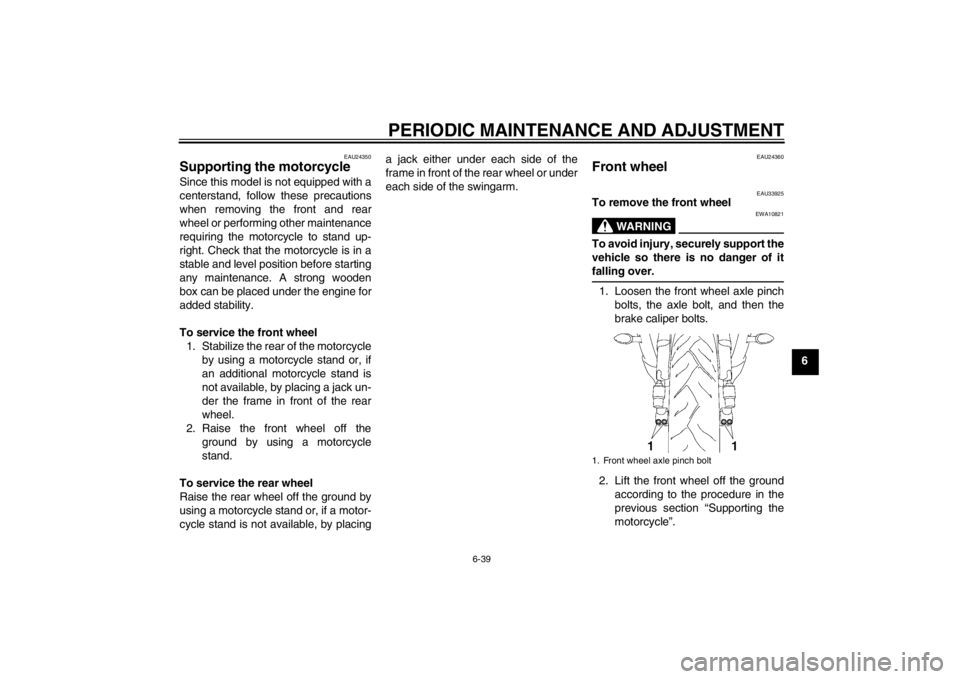
PERIODIC MAINTENANCE AND ADJUSTMENT
6-39
6
EAU24350
Supporting the motorcycle Since this model is not equipped with a
centerstand, follow these precautions
when removing the front and rear
wheel or performing other maintenance
requiring the motorcycle to stand up-
right. Check that the motorcycle is in a
stable and level position before starting
any maintenance. A strong wooden
box can be placed under the engine for
added stability.
To service the front wheel1. Stabilize the rear of the motorcycle by using a motorcycle stand or, if
an additional motorcycle stand is
not available, by placing a jack un-
der the frame in front of the rear
wheel.
2. Raise the front wheel off the ground by using a motorcycle
stand.
To service the rear wheel
Raise the rear wheel off the ground by
using a motorcycle stand or, if a motor-
cycle stand is not available, by placing a jack either under each side of the
frame in front of the rear wheel or under
each side of the swingarm.
EAU24360
Front wheel
EAU33925
To remove the front wheel
WARNING
EWA10821
To avoid injury, securely support the
vehicle so there is no danger of it
falling over.1. Loosen the front wheel axle pinch
bolts, the axle bolt, and then the
brake caliper bolts.
2. Lift the front wheel off the ground according to the procedure in the
previous section “Supporting the
motorcycle”.1. Front wheel axle pinch bolt
U1JSE0E0.book Page 39 Wednesday, July 27, 2011 10:34 AM
Page 92 of 112
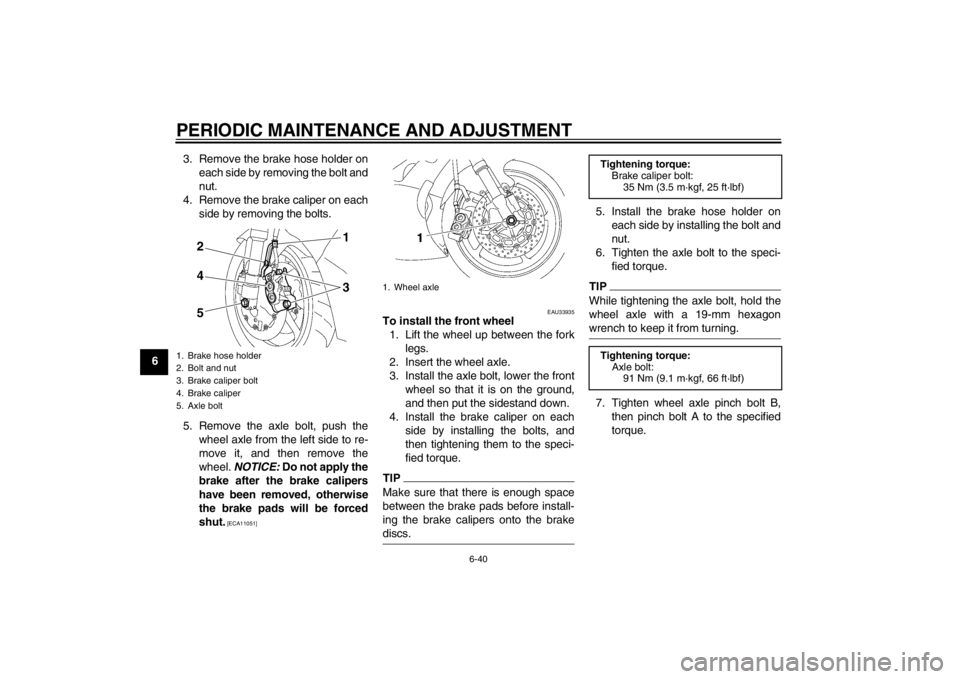
PERIODIC MAINTENANCE AND ADJUSTMENT
6-40
63. Remove the brake hose holder on
each side by removing the bolt and
nut.
4. Remove the brake caliper on each side by removing the bolts.
5. Remove the axle bolt, push the wheel axle from the left side to re-
move it, and then remove the
wheel. NOTICE: Do not apply the
brake after the brake calipers
have been removed, otherwise
the brake pads will be forced
shut.
[ECA11051] EAU33935
To install the front wheel
1. Lift the wheel up between the fork legs.
2. Insert the wheel axle.
3. Install the axle bolt, lower the front wheel so that it is on the ground,
and then put the sidestand down.
4. Install the brake caliper on each side by installing the bolts, and
then tightening them to the speci-
fied torque.TIPMake sure that there is enough space
between the brake pads before install-
ing the brake calipers onto the brake
discs.
5. Install the brake hose holder oneach side by installing the bolt and
nut.
6. Tighten the axle bolt to the speci- fied torque.TIPWhile tightening the axle bolt, hold the
wheel axle with a 19-mm hexagon
wrench to keep it from turning.7. Tighten wheel axle pinch bolt B,then pinch bolt A to the specified
torque.
1. Brake hose holder
2. Bolt and nut
3. Brake caliper bolt
4. Brake caliper
5. Axle bolt
31
2
4
5
1. Wheel axle
Tightening torque:Brake caliper bolt:
35 Nm (3.5 m·kgf, 25 ft·lbf)
Tightening torque: Axle bolt:91 Nm (9.1 m·kgf, 66 ft·lbf)
U1JSE0E0.book Page 40 Wednesday, July 27, 2011 10:34 AM
Page 93 of 112
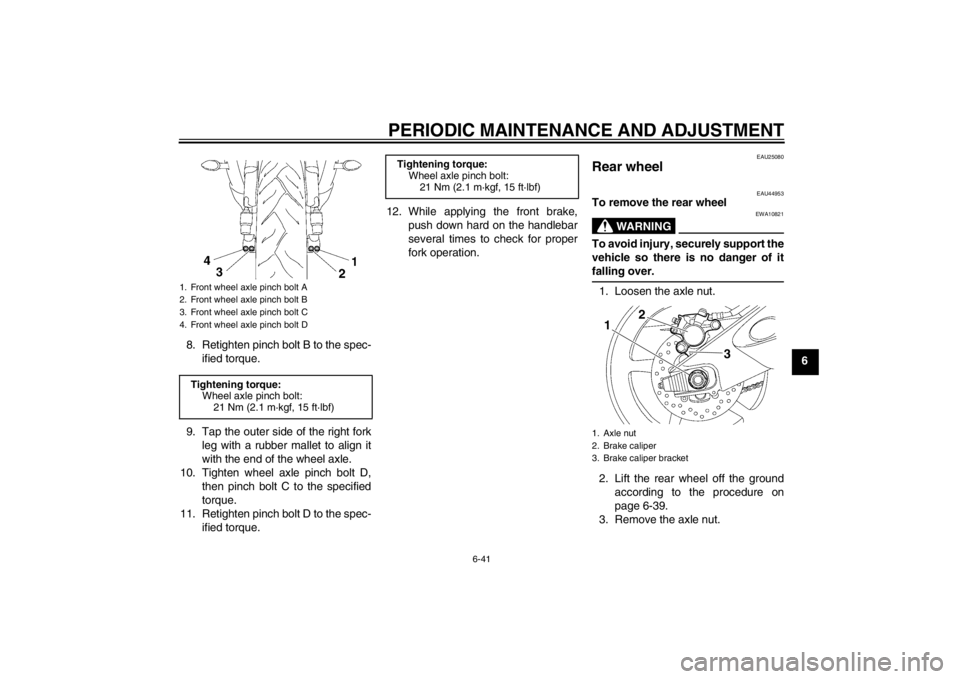
PERIODIC MAINTENANCE AND ADJUSTMENT
6-41
6
8. Retighten pinch bolt B to the spec-
ified torque.
9. Tap the outer side of the right fork leg with a rubber mallet to align it
with the end of the wheel axle.
10. Tighten wheel axle pinch bolt D, then pinch bolt C to the specified
torque.
11. Retighten pinch bolt D to the spec- ified torque. 12. While applying the front brake,
push down hard on the handlebar
several times to check for proper
fork operation.
EAU25080
Rear wheel
EAU44953
To remove the rear wheel
WARNING
EWA10821
To avoid injury, securely support the
vehicle so there is no danger of it
falling over.1. Loosen the axle nut.
2. Lift the rear wheel off the groundaccording to the procedure on
page 6-39.
3. Remove the axle nut.
1. Front wheel axle pinch bolt A
2. Front wheel axle pinch bolt B
3. Front wheel axle pinch bolt C
4. Front wheel axle pinch bolt DTightening torque: Wheel axle pinch bolt:21 Nm (2.1 m·kgf, 15 ft·lbf)
Tightening torque: Wheel axle pinch bolt:
21 Nm (2.1 m·kgf, 15 ft·lbf)
1. Axle nut
2. Brake caliper
3. Brake caliper bracket
1
2
3
U1JSE0E0.book Page 41 Wednesday, July 27, 2011 10:34 AM
Page 94 of 112
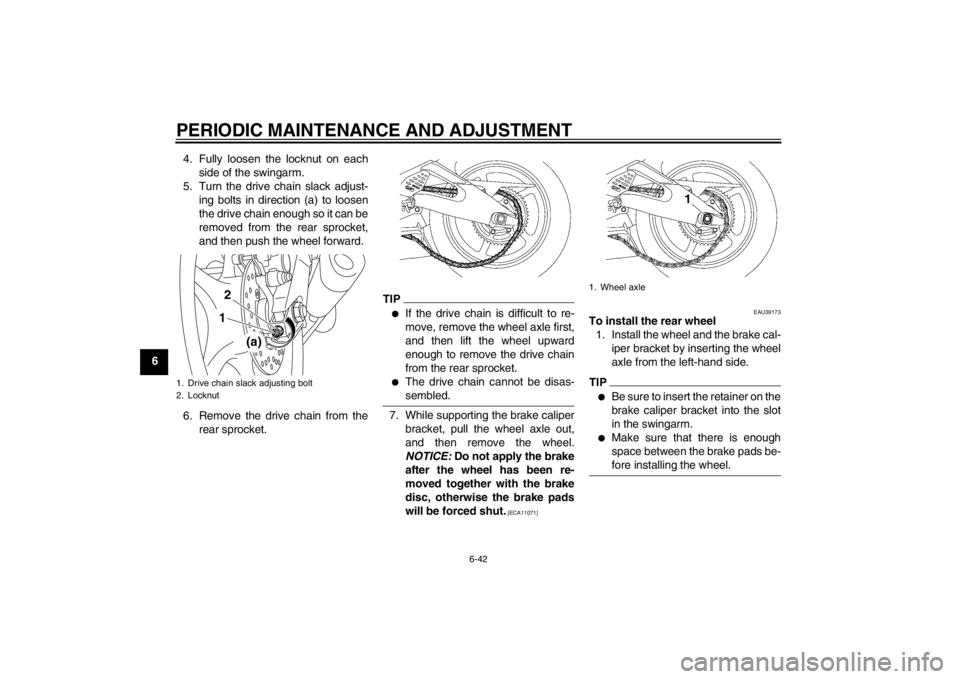
PERIODIC MAINTENANCE AND ADJUSTMENT
6-42
64. Fully loosen the locknut on each
side of the swingarm.
5. Turn the drive chain slack adjust- ing bolts in direction (a) to loosen
the drive chain enough so it can be
removed from the rear sprocket,
and then push the wheel forward.
6. Remove the drive chain from the rear sprocket.
TIP●
If the drive chain is difficult to re-
move, remove the wheel axle first,
and then lift the wheel upward
enough to remove the drive chain
from the rear sprocket.
●
The drive chain cannot be disas-
sembled.
7. While supporting the brake caliperbracket, pull the wheel axle out,
and then remove the wheel.
NOTICE: Do not apply the brake
after the wheel has been re-
moved together with the brake
disc, otherwise the brake pads
will be forced shut.
[ECA11071] EAU39173
To install the rear wheel
1. Install the wheel and the brake cal- iper bracket by inserting the wheel
axle from the left-hand side.TIP●
Be sure to insert the retainer on the
brake caliper bracket into the slot
in the swingarm.
●
Make sure that there is enough
space between the brake pads be-
fore installing the wheel.
1. Drive chain slack adjusting bolt
2. Locknut
(a)
12
1. Wheel axle
U1JSE0E0.book Page 42 Wednesday, July 27, 2011 10:34 AM
Page 95 of 112
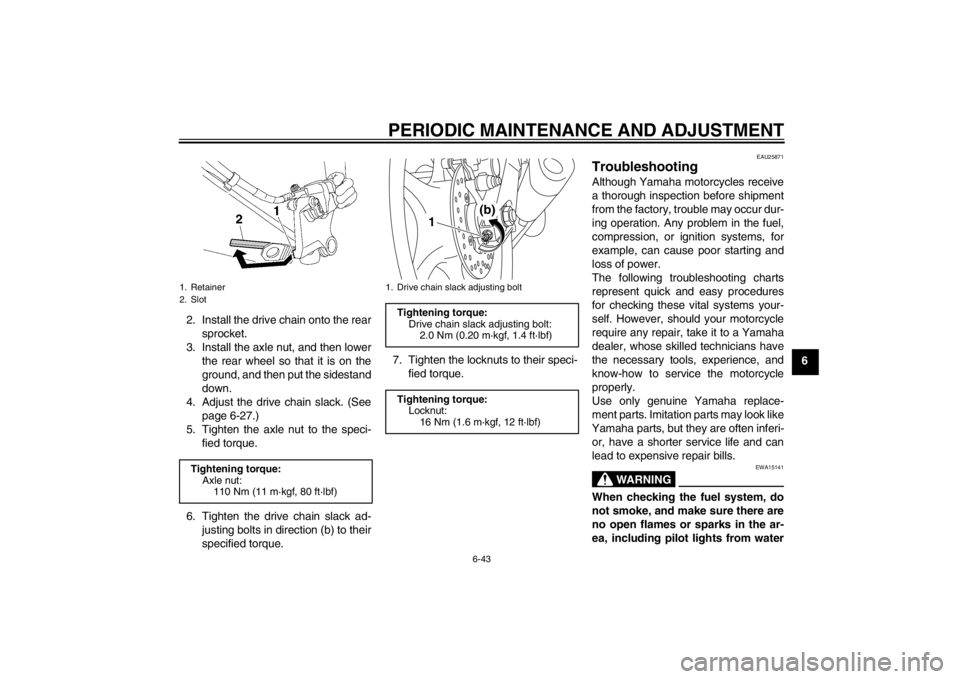
PERIODIC MAINTENANCE AND ADJUSTMENT
6-43
6
2. Install the drive chain onto the rear
sprocket.
3. Install the axle nut, and then lower the rear wheel so that it is on the
ground, and then put the sidestand
down.
4. Adjust the drive chain slack. (See page 6-27.)
5. Tighten the axle nut to the speci- fied torque.
6. Tighten the drive chain slack ad- justing bolts in direction (b) to their
specified torque. 7. Tighten the locknuts to their speci-
fied torque.
EAU25871
Troubleshooting Although Yamaha motorcycles receive
a thorough inspection before shipment
from the factory, trouble may occur dur-
ing operation. Any problem in the fuel,
compression, or ignition systems, for
example, can cause poor starting and
loss of power.
The following troubleshooting charts
represent quick and easy procedures
for checking these vital systems your-
self. However, should your motorcycle
require any repair, take it to a Yamaha
dealer, whose skilled technicians have
the necessary tools, experience, and
know-how to service the motorcycle
properly.
Use only genuine Yamaha replace-
ment parts. Imitation parts may look like
Yamaha parts, but they are often inferi-
or, have a shorter service life and can
lead to expensive repair bills.
WARNING
EWA15141
When checking the fuel system, do
not smoke, and make sure there are
no open flames or sparks in the ar-
ea, including pilot lights from water
1. Retainer
2. SlotTightening torque:Axle nut:110 Nm (11 m·kgf, 80 ft·lbf)
1. Drive chain slack adjusting bolt
Tightening torque: Drive chain slack adjusting bolt:2.0 Nm (0.20 m·kgf, 1.4 ft·lbf)
Tightening torque: Locknut:
16 Nm (1.6 m·kgf, 12 ft·lbf)
(b)
1
U1JSE0E0.book Page 43 Wednesday, July 27, 2011 10:34 AM
Page 96 of 112
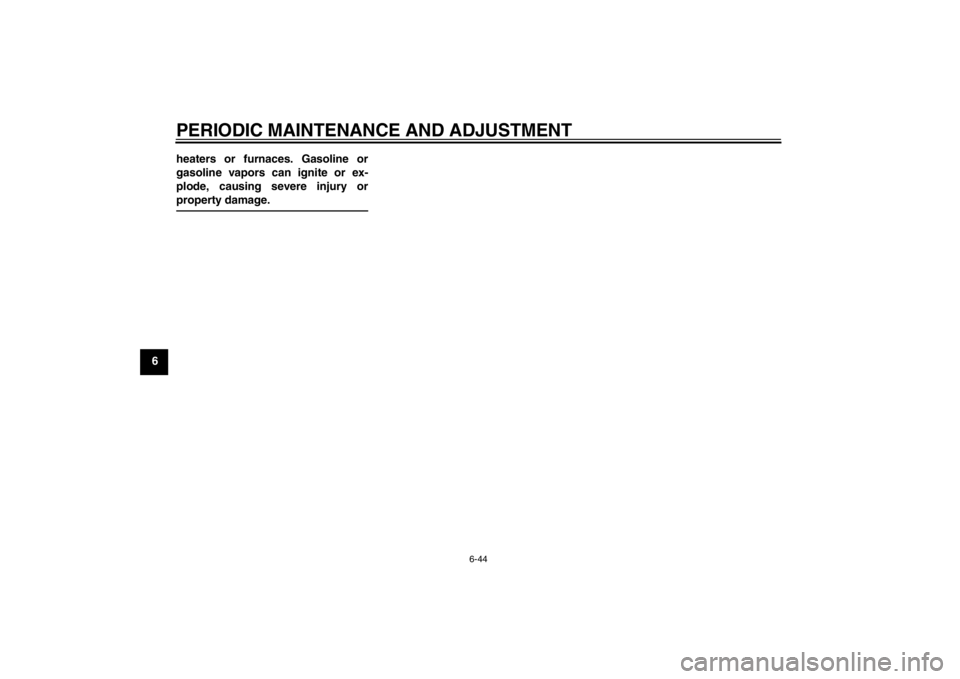
PERIODIC MAINTENANCE AND ADJUSTMENT
6-44
6heaters or furnaces. Gasoline or
gasoline vapors can ignite or ex-
plode, causing severe injury or
property damage.
U1JSE0E0.book Page 44 Wednesday, July 27, 2011 10:34 AM
Page 97 of 112

PERIODIC MAINTENANCE AND ADJUSTMENT
6-45
6
EAU42503
Troubleshooting charts Starting problems or poor engine performance
Check the fuel level in
the fuel tank.1. Fuel
There is enough fuel.There is no fuel.
Check the compression.
Supply fuel.
The engine does not start.
Check the compression.
Operate the electric starter.2. Compression
There is compression.
There is no compression.
Check the ignition. Have a Yamaha dealer
check the vehicle.
Remove the spark plugs
and check the electrodes.3. Ignition
Wipe off with a dry cloth and correct the
spark plug gaps, or replace the spark plugs.
Have a Yamaha dealer check the vehicle.
The engine does not start.
Have a Yamaha dealer
check the vehicle.
The engine does not start.
Check the battery.
Operate the electric starter.4. Battery
The engine turns over
quickly.
The engine turns over
slowly.
The battery is good.Check the battery lead connections,
and have a Yamaha dealer charge
the battery if necessary.
DryWet
Operate the electric starter.
U1JSE0E0.book Page 45 Wednesday, July 27, 2011 10:34 AM
Page 98 of 112
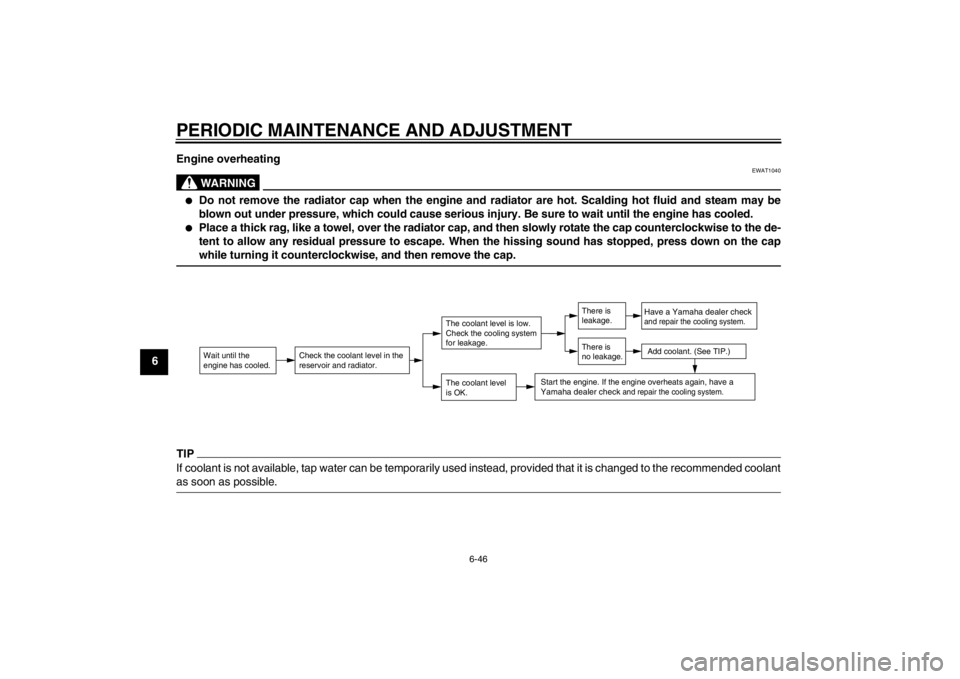
PERIODIC MAINTENANCE AND ADJUSTMENT
6-46
6Engine overheating
WARNING
EWAT1040
●
Do not remove the radiator cap when the engine and
radiator are hot. Scalding hot fluid and steam may be
blown out under pressure, which could cause serious injury. Be sure to wait until the engine has cooled.
●
Place a thick rag, like a towel, over the radiator cap, and then slowly rotate the cap counterclockwise to the de-
tent to allow any residual pressure to escape. When the hissing sound has stopped, press down on the cap
while turning it counterclockwise, and then remove the cap.
TIPIf coolant is not available, tap water can be temporarily used instead, provided that it is changed to the recommended coolant
as soon as possible.
Wait until the
engine has cooled.
Check the coolant level in the
reservoir and radiator.
The coolant level
is OK.The coolant level is low.
Check the cooling system
for leakage.
Have a Yamaha dealer checkand repair the cooling system.Add coolant. (See TIP.)
Start the engine. If the engine overheats again,
have a
Yamaha dealer check
and repair the cooling system.
There is
leakage.
There is
no leakage.
U1JSE0E0.book Page 46 Wednesday, July 27, 2011 10:34 AM
Page 99 of 112
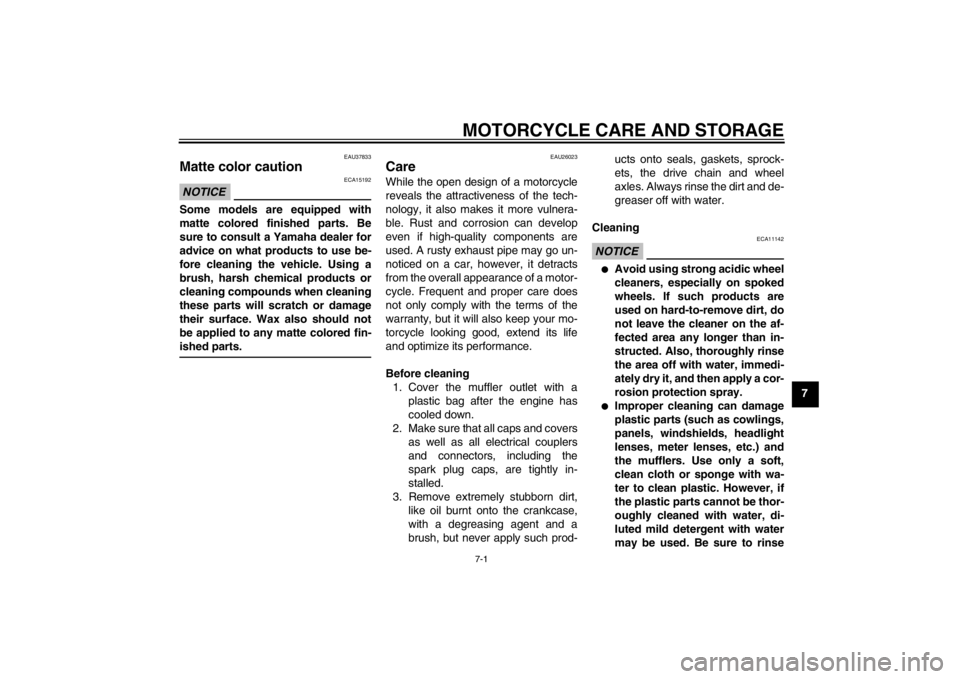
MOTORCYCLE CARE AND STORAGE
7-1
7
EAU37833
Matte color caution NOTICE
ECA15192
Some models are equipped with
matte colored finished parts. Be
sure to consult a Yamaha dealer for
advice on what products to use be-
fore cleaning the vehicle. Using a
brush, harsh chemical products or
cleaning compounds when cleaning
these parts will scratch or damage
their surface. Wax also should not
be applied to any matte colored fin-
ished parts.
EAU26023
Care While the open design of a motorcycle
reveals the attractiveness of the tech-
nology, it also makes it more vulnera-
ble. Rust and corrosion can develop
even if high-quality components are
used. A rusty exhaust pipe may go un-
noticed on a car, however, it detracts
from the overall appearance of a motor-
cycle. Frequent and proper care does
not only comply with the terms of the
warranty, but it will also keep your mo-
torcycle looking good, extend its life
and optimize its performance.
Before cleaning1. Cover the muffler outlet with a plastic bag after the engine has
cooled down.
2. Make sure that all caps and covers as well as all electrical couplers
and connectors, including the
spark plug caps, are tightly in-
stalled.
3. Remove extremely stubborn dirt, like oil burnt onto the crankcase,
with a degreasing agent and a
brush, but never apply such prod- ucts onto seals, gaskets, sprock-
ets, the drive chain and wheel
axles. Always rinse the dirt and de-
greaser off with water.
Cleaning
NOTICE
ECA11142
●
Avoid using strong acidic wheel
cleaners, especially on spoked
wheels. If such products are
used on hard-to-remove dirt, do
not leave the cleaner on the af-
fected area any longer than in-
structed. Also, thoroughly rinse
the area off with water, immedi-
ately dry it, and then apply a cor-
rosion protection spray.
●
Improper cleaning can damage
plastic parts (such as cowlings,
panels, windshields, headlight
lenses, meter lenses, etc.) and
the mufflers. Use only a soft,
clean cloth or sponge with wa-
ter to clean plastic. However, if
the plastic parts cannot be thor-
oughly cleaned with water, di-
luted mild detergent with water
may be used. Be sure to rinse
U1JSE0E0.book Page 1 Wednesday, July 27, 2011 10:34 AM
Page 100 of 112
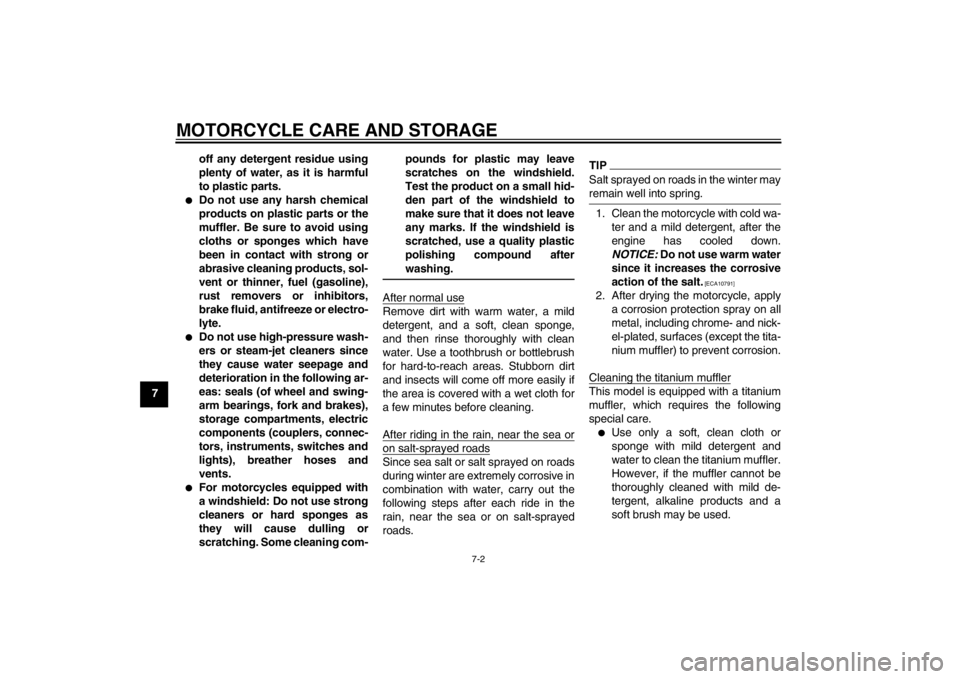
MOTORCYCLE CARE AND STORAGE
7-2
7off any detergent residue using
plenty of water, as it is harmful
to plastic parts.
●
Do not use any harsh chemical
products on plastic parts or the
muffler. Be sure to avoid using
cloths or sponges which have
been in contact with strong or
abrasive cleaning products, sol-
vent or thinner, fuel (gasoline),
rust removers or inhibitors,
brake fluid, antifreeze or electro-
lyte.
●
Do not use high-pressure wash-
ers or steam-jet cleaners since
they cause water seepage and
deterioration in the following ar-
eas: seals (of wheel and swing-
arm bearings, fork and brakes),
storage compartments, electric
components (couplers, connec-
tors, instruments, switches and
lights), breather hoses and
vents.
●
For motorcycles equipped with
a windshield: Do not use strong
cleaners or hard sponges as
they will cause dulling or
scratching. Some cleaning com- pounds for plastic may leave
scratches on the windshield.
Test the product on a small hid-
den part of the windshield to
make sure that it does not leave
any marks. If the windshield is
scratched, use a quality plastic
polishing compound after
washing.
After normal useRemove dirt with warm water, a mild
detergent, and a soft, clean sponge,
and then rinse thoroughly with clean
water. Use a toothbrush or bottlebrush
for hard-to-reach areas. Stubborn dirt
and insects will come off more easily if
the area is covered with a wet cloth for
a few minutes before cleaning.
After riding in the rain, near the sea oron salt-sprayed roadsSince sea salt or salt sprayed on roads
during winter are extremely corrosive in
combination with water, carry out the
following steps after each ride in the
rain, near the sea or on salt-sprayed
roads.
TIPSalt sprayed on roads in the winter may
remain well into spring.1. Clean the motorcycle with cold wa-
ter and a mild detergent, after the
engine has cooled down.
NOTICE: Do not use warm water
since it increases the corrosive
action of the salt.
[ECA10791]
2. After drying the motorcycle, apply a corrosion protection spray on all
metal, including chrome- and nick-
el-plated, surfaces (except the tita-
nium muffler) to prevent corrosion.
Cleaning the titanium mufflerThis model is equipped with a titanium
muffler, which requires the following
special care.●
Use only a soft, clean cloth or
sponge with mild detergent and
water to clean the titanium muffler.
However, if the muffler cannot be
thoroughly cleaned with mild de-
tergent, alkaline products and a
soft brush may be used.
U1JSE0E0.book Page 2 Wednesday, July 27, 2011 10:34 AM